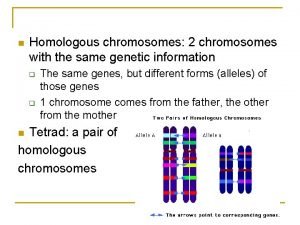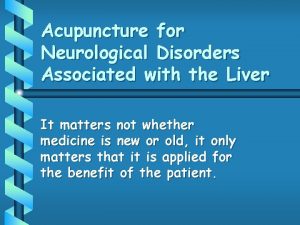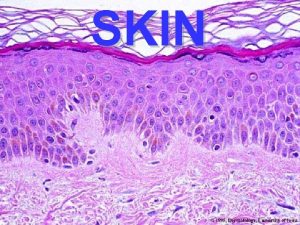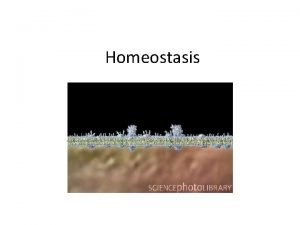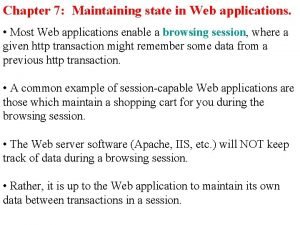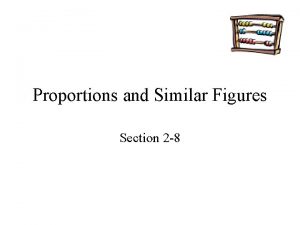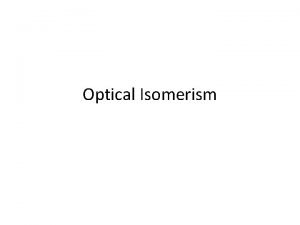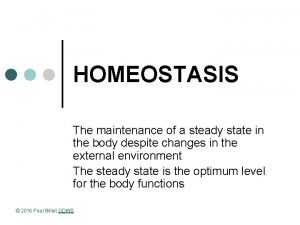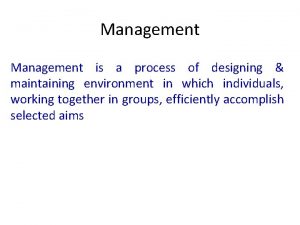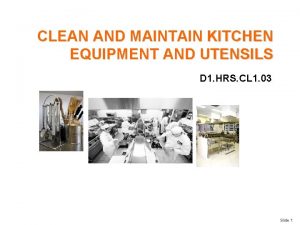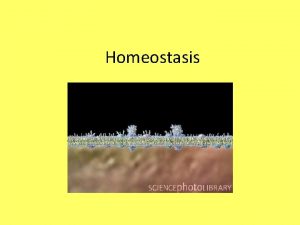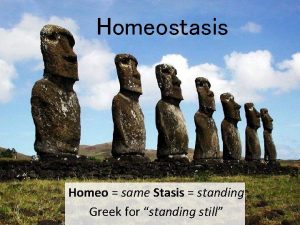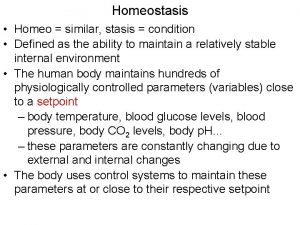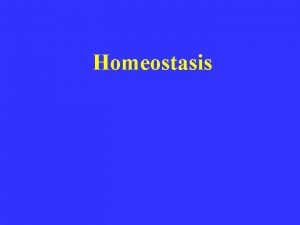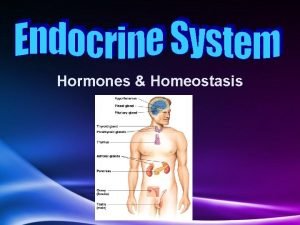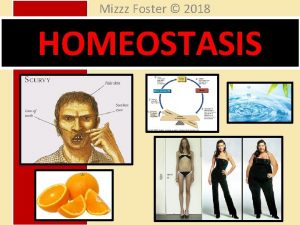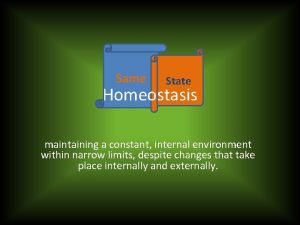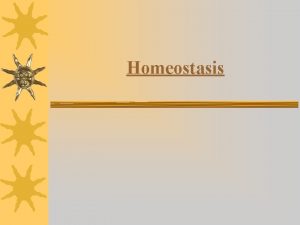Homeostasis HomeoWhat Homeo Same Stasis State Homeostasis Maintaining

































- Slides: 33

Homeostasis

Homeo-What? • Homeo= Same • Stasis= State • Homeostasis: Maintaining a constant internal balance – Example: When your body temperature is over 98. 6 o, your body is out of homeostasis – Example: When you are dehydrated, your body is out of homeostasis

How do we maintain homeostasis? • Cell Membranes! • Surrounds the outer portion of an animal cell • Is found inside of the cell wall of a plant cell

Cell Membrane Structure • Phospholipid- Phosphate and lipid that forms the “wall” portion of the membrane – Small molecules such as H 2 O and O 2 can pass through – Phosphate- Is polar and hydrophilic (water loving) – Lipid- Is non-polar and hydrophobic (water hater) • Protein-Protein portion that forms the “door” portion of the membrane – Allows large molecules (such as Na and K) to pass into or out of the cell


Phospholipid Structure Phosphate-hydrophilic Outside portion of the cell membrane Lipid-hydrophobic Inside portion of the cell membrane

Comp Book Time! Complete Catch It Questions 1 -2

Semi-Permeable Membrane • Cell membrane allows some molecules to enter and others to exit the cell • Keeps unneeded molecules out of the cell • Is also called selectively permeable membrane Outside of cell Inside of cell

Fluid Mosaic Model • Cell membranes are in constant motion • Is called the Fluid Mosaic Model • Are moving to maintain homeostasis – Letting certain molecules in and out as needed http: //telstar. ote. cmu. edu/biology/Membrane. Page/index 2. html

How do cells move molecules? • Cells maintain homeostasis by moving molecules in and out of the cell membrane • Passive Transport – Requires no cellular energy (ATP made by the mitochondria) – Example: Osmosis and Diffusion • Active Transport – Requires the usage of ATP – Example: Na/K pumps

Concentration Gradient

Passive Transport • No cellular energy (ATP) is used • Diffusion – The movement of molecules from an area of high concentration to low concentration

• Equilibrium: When the concentration of molecules on both sides of the membrane are equal – No more movement will happen Molecule of dye Membrane Equal on both sides

• Facilitated Diffusion: – Facilitate- “to help” – Molecules that can not pass through the phospholipid layer pass through proteins – Glucose • Blood sugar

• Osmosis: – The diffusion of H 2 O across a cell membrane – H 2 O moves from high concentration to lower concentration Not a lot of H 2 O=Lower concentration A lot of H 2 O=Higher concentration

• Just a reminder…. . – Solute: What is being dissolved – Solvent: What is doing the dissolving • Water is the universal solvent – When making sweet tea • The water is the solvent • The tea and sugar are the solutes

Osmosis creates different conditions for cells 1. Hypotonic: – Hypo= lower – Concentration of solute molecules is lower in the environment than in the cell – H 2 O moves into the cell and it swells • Eventually the cell will burst if H 2 O does not move out of the cell (cytolysis)

Environment is 90% H 2 O 90% +10% Na. Cl= 100% Solution is 80% H 2 O 90% +20% Na. Cl= 100%

2. Hypertonic – Hyper= Higher – Concentration of solute molecules is higher in the environment than in the cell – H 2 O will leave the cell and it will shrink – Example: Dehydration

Environment is 80% H 2 O 80% +20% Na. Cl= 100% Cell is 90% H 2 O 90% +10% Na. Cl= 100%

3. Isotonic – Iso= equal – The concentration of the solute molecules is equal on both sides of the cell membrane – Cells neither gain nor lose H 2 O – Cells are in homeostasis


Comp Book Time! Complete Catch It Questions 3 -6

• Cytolysis: – An animal cell in a hypotonic environment will eventually swell and burst • Turgor Pressure: – A plant cell is restricted by the cell wall – A plant cell in a hypotonic environment will stand up to gain access to more sunlight • Cells do not burst due to the cell wall

• Plasmolysis: When a plant cell is in a hypertonic environment, water leaves the cell and the vacuole shrinks – Plant wilting

Active Transport • Cellular Energy (ATP) is used • Moving molecules from an area of low concentration to an area of high concentration • Na/K pumps in neurons

• Endocytosis: – Endo= into – Cyto= cell – Cell membranes change shape to allow large molecules to enter the cell – Example: cells engulf protein molecules

• Types of Endocytosis 1. – – – Pinocytosis Pino= Drinking Cyto= Cell The movement of solutes or fluids into the cell

2. Phagocytosis – Phag= to eat – Cyto= cell – The movement of large particles or entire organisms into a cell – Example: White Blood Cells (wbc), Amoeba

• Exocytosis – Exo= exit – Cyto= cell – Passage of large molecules to the outside of the cell – The cell membrane changes shape – Example: Waste products are secreted into the environment, Golgi Body secretions, Hormones

Comp Book Time! Complete Catch It Questions 7 -10

Animal Type of cell - ______ hypertonic Type of solution - _______ 8. 5% Na. Cl 91. 5% H 2 O out How will water move? _____ 45% Na. Cl osmosis By what process? _______ 55% H 2 O in How will salt move? ______ diffusion By what process? ________ shrink in size What will happen to the cell? _______ plasmolysis Biological term - _________

Plant Type of cell - ______ 8. 5% Na. Cl hypotonic Type of solution - _______ 91. 5% H 2 O in How will water move? _____ osmosis By what process? _______ 0% Na. Cl Distilled water 100% H 2 O out How will salt move? ______ diffusion By what process? ________ swell and become rigid What will happen to the cell? _______ turgor pressure Biological term - _________
 Homologous pairs
Homologous pairs Bioflix activity homeostasis hormones and homeostasis
Bioflix activity homeostasis hormones and homeostasis Bioflix activity homeostasis hormones and homeostasis
Bioflix activity homeostasis hormones and homeostasis Hypostasis vs bruise
Hypostasis vs bruise Hypo stasis
Hypo stasis Cistache
Cistache Stasis in mansion of mind
Stasis in mansion of mind Stasis questions
Stasis questions Stasis dermatitis
Stasis dermatitis Stasis papillae
Stasis papillae Osmosis stasis
Osmosis stasis Maintaining state in web applications
Maintaining state in web applications Same place same time
Same place same time Same place same passion
Same place same passion Similar figures have the same but not necessarily the same
Similar figures have the same but not necessarily the same Similar figures / proportion (level 2)
Similar figures / proportion (level 2) Cis trans vs e z
Cis trans vs e z Steady state homeostasis
Steady state homeostasis Importance of recording and reporting in nursing
Importance of recording and reporting in nursing The process of designing and maintaining an environment
The process of designing and maintaining an environment Maintaining deliverance
Maintaining deliverance Building and maintaining a website
Building and maintaining a website Clean and maintain kitchen tools and premises
Clean and maintain kitchen tools and premises Components of a retail image
Components of a retail image Establishing and maintaining a retail image
Establishing and maintaining a retail image Chapter 17 owning and maintaining a car
Chapter 17 owning and maintaining a car Maintaining a healthy body composition and body image
Maintaining a healthy body composition and body image Maintaining a professional image
Maintaining a professional image Class maintaining prefix
Class maintaining prefix Chapter 15:4 observing standard precautions
Chapter 15:4 observing standard precautions Creating vision and strategic direction
Creating vision and strategic direction Managing weight and eating behaviors
Managing weight and eating behaviors Purchasing and maintaining a computer
Purchasing and maintaining a computer Potential tension between maintaining confidentiality
Potential tension between maintaining confidentiality
